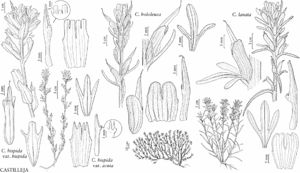Castilleja lanata
in W. H. Emory, Rep. U.S. Mex. Bound. 2(1): 118. 1859.
Subshrubs or herbs, perennial, 1.8–9(–10) dm; from a woody caudex; with a thick, woody taproot or system to thick, branched roots. Stems few to many, erect to ascending, unbranched, sometimes branched distally, sometimes with leafy axillary shoots, lanate to woolly, hairs dense, spreading to weakly appressed, white to yellowish, medium length, soft, moderately branched or unbranched in different populations, sometimes mixed, eglandular, rarely short stipitate-glandular, mostly obscuring surface. Leaves green to purple, often hidden by matted, white hairs, linear to narrowly oblong or narrowly lanceolate, (1–)2–7(–10) cm, not fleshy, margins plane, flat, sometimes involute, 0–3-lobed, apex rounded, sometimes acute; lobes spreading, linear or narrowly oblong, apex rounded to acute. Inflorescences 2–19 × 1.5–5 cm; bracts proximally pale greenish to greenish gray, distally bright red to orange-red, sometimes pinkish, magenta, or salmon, rarely yellow, oblong to narrowly lanceolate or narrowly oblanceolate, deeply 0–3(–5)-lobed; lobes spreading, oblanceolate or linear, long, arising below mid length, distal bract apex usually rounded. Calyces proximally whitish to green, central band whitish, distal 1/3 colored as bract lobes, sometimes lighter or deeper, 15–29 mm; abaxial and adaxial clefts 6–14 mm, ca. 50% of calyx length, deeper than laterals, lateral 0–5 mm, 0–5(–15)% of calyx length; lobes oblong to broadly triangular, apex rounded, truncate, or emarginate. Corollas curved in proximal 1/3, 23–35(–42) mm; tube 12–17 mm; beak exserted, adaxially greenish to yellowish, 11–22 mm; abaxial lip dark green, reduced, 1–4 mm, ca. 20% as long as beak; teeth incurved, reduced, green, 0.5–2.5 mm. 2n = 24.
Phenology: Flowering year-round.
Habitat: Dry rocky slopes, ridges, canyons, flats, valleys, montane.
Elevation: 300–2300 m.
Distribution
Ariz., N.Mex., Tex., Mexico (Baja California, Chihuahua, Coahuila, Durango, Nuevo León, San Luis Potosí, Sonora, Tamaulipas, Zacatecas).
Discussion
Most records of Castilleja lanata are from the southern third of Arizona, New Mexico, and southwestern Texas. Plants sometimes referred to C. lanata from the Channel Islands of California are assigned here to C. hololeuca, an insular endemic. In northern Mexico, C. lanata extends from San Luis Potosí and Nuevo León westward to Sonora, with a disjunct distribution in central Baja California, where it overlaps the southern limits of a related species, C. foliolosa. Castilleja lanata inhabits a wide spectrum of soils and elevations and does not co-occur with the closely related C. galehintoniae in Nuevo León, where the latter is limited to limestone and gypsum substrates in a narrow elevational range. Hybrids of C. lanata with C. sessiliflora are known from Pecos County, Texas.
Selected References
None.
